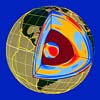| . |  |
. |
Providence RI (SPX) Nov 27, 2006 Scientific business-as-usual became an adventure in ocean floor geology for Donald Forsyth, Alberto Saal and their students, when the instruments they were supposed to retrieve for another scientist went missing. The researchers quickly collected samples and data that strongly suggested they had just missed a major episode of seafloor spreading -- and the missing instruments had been buried in lava. Forsyth and Saal, professors of geology at Brown University, were returning from a research cruise to map an area of seafloor near the Galapagos Islands last April, along with seven Brown graduate students and four undergraduates. The cruise route took the ship right by a highly-studied section of the mid-ocean ridge called the East Pacific Rise. The area had experienced an episode of seafloor spreading in 1991 and was being closely monitored as part of the RIDGE2000 program sponsored by the National Science Foundation. A team of researchers headed by Maya Tolstoy, a geologist at Columbia's Earth Institute, had placed an array of ocean-bottom seismometers (OBS) at the spot in 2003 and collected data from the vibration-recording devices at least once a year. With ship-time at a premium, it's common for a research ship to make a quick stop to download such data. The task should have been simple. The seismometers are anchored to the seafloor by a mechanism that will release them and allow them to float to the surface when triggered by an acoustic signal. The crew and researchers scoop up the microwave-oven sized devices and return them to shore, replacing them with new ones that will monitor seismic activity for the next year. It's un-common for an OBS to be lost due to mechanical malfunction. This time, however, the crew was only able to recover four of the 12 instruments that should have been there. Five instruments did not even acknowledge the anchor release command. Three others signaled that the command had been received, but did not release the devices. The ones they could recover were also the farthest away from the axial summit trough, the ridge where magma rises, creating fresh crust as the seafloor plates separate. That information, together with a pattern of increasing seismic activity at the site over the past two years, told them that the seismometers might well have been swallowed up by the very eruption they were supposed to measure. Though they had little extra time in the cruise schedule and lacked the cameras or submersible that would have been ideal for investigating the mysterious disappearance, the team got to work gathering as much data as they could before heading back to port in San Diego. They found that the water over the spreading site was warmer and murkier than the surrounding seawater - just as it would have been had there been a recent eruption or spreading event. A quickly-deployed dredge also yielded chunks of freshly deposited glass and lavas that appeared to be coated with a layer of bacteria - characteristic of what grows in the seafloor vents. "It wasn't a sure thing," says Forsyth, "but we were pretty confident. The OBS's were gone. We had the light scattering and the really fresh rocks with no sediment accumulation. For all we knew it might have just erupted." Forsyth contacted the Columbia researchers and the RIDGE2000 rapid response team, who quickly arranged for a visit by the R/V New Horizon, carrying a deep-sea camera that could be towed directly over the site. When the visual images became available, it was clear that most of the seismometers had indeed been enveloped in lava, and one had even been carried away from its original location on an undersea flow. So far, Tolstoy's team has only been able to recover data from two of the 12 instruments, but those two provide a detailed picture of the vibrations that precede a spreading event. For the first time, researchers had an ear to earth's belly as new crust was being born. The data from the two seismometers and the on-site observations will appear online at the Science Express web site, on Thursday, November 23, 2006. The data they have draws a picture of increasingly frequent cracking events - building to a cres-cendo in late January 2006. Over a period of about six hours, magma appears to have broken through the ridge, briefly filled the trough along 18 kilometers of ridge summit, and flowed up to a kilometer out onto the seafloor. The biggest vibrations were seen during the first hour of this period, suggesting that magma broke through first in one location and then fed the rest of the eruption. Within about a week after this key event, the vibrations returned to the baseline levels seen when the seismometers were first deployed in 2003. Similarly, the Brown students have returned to their usual activities, but they won't soon forget their chance to see geology in action. Related Links Brown University Brown University Research Cruise Student blog When the Earth Quakes
 Santa Cruz CA (SPX) Nov 27, 2006
Santa Cruz CA (SPX) Nov 27, 2006For the first time, scientists have directly measured the amount of heat flowing from the molten metal of Earth's core into a region at the base of the mantle, a process that helps drive both the movement of tectonic plates at the surface and the geodynamo in the core that generates Earth's magnetic field. |
|
| The content herein, unless otherwise known to be public domain, are Copyright 1995-2006 - SpaceDaily.AFP and UPI Wire Stories are copyright Agence France-Presse and United Press International. ESA PortalReports are copyright European Space Agency. All NASA sourced material is public domain. Additionalcopyrights may apply in whole or part to other bona fide parties. Advertising does not imply endorsement,agreement or approval of any opinions, statements or information provided by SpaceDaily on any Web page published or hosted by SpaceDaily. Privacy Statement |